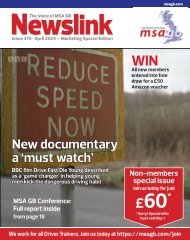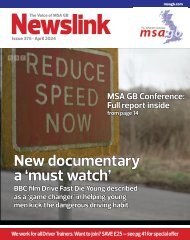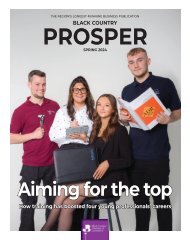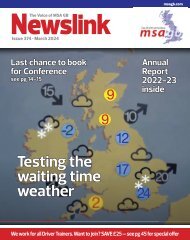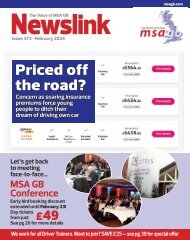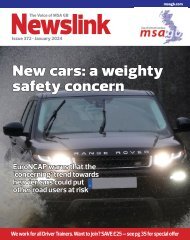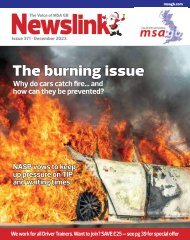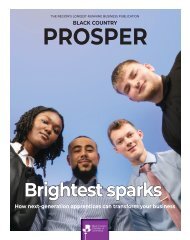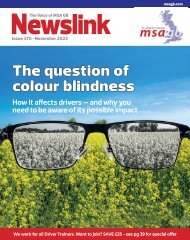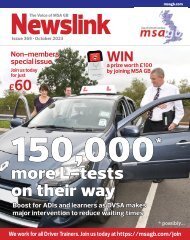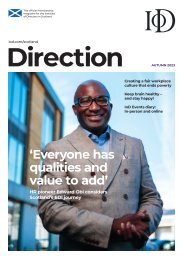Newslink
Motor Schools Association membership magazine, driver training and testing, ADIs, road safety
Motor Schools Association membership magazine, driver training and testing, ADIs, road safety
Create successful ePaper yourself
Turn your PDF publications into a flip-book with our unique Google optimized e-Paper software.
Regional News<br />
New research on the threats posed by rural roads prompted two<br />
contributions on the subject this issue. On this page, Janet Stewart from<br />
MSA Greater London offers her thoughts and, facing, Guy Annan from<br />
MSA Western does likewise. By their nature they cover the same facts and<br />
figures but offer different takes on what is an important subject<br />
Rural road risks make it vital you take<br />
your learners out into the country<br />
Alex Brownlee<br />
MSA Greater London<br />
A quick note on the MSA AGM Greater<br />
London meeting, held at the end of<br />
November. It was very well attended –<br />
via Zoom, of course! Many thanks to the<br />
National Chairman Peter Harvey MBE<br />
and Geoff Little Deputy National<br />
Chairman for taking part, and to all those<br />
members who participated.<br />
Do you teach on rural roads?<br />
I have been supplied this article by<br />
Janet Stewart, one of the MSA GB<br />
Greater London committee members.<br />
It’s easy for me to teach on all types of<br />
roads. I live almost on top of the M25<br />
and can easily reach the M1, the M40,<br />
lots of dual carriageways and the city<br />
roads of central London.<br />
However, I actually live on a rural-style<br />
lane with passing places, and some of<br />
the roads around here are such<br />
backwaters that they have grass growing<br />
down the middle.<br />
So, I’m lucky – though despite my<br />
good luck (in a manner of speaking) to<br />
have a broad range of road types on my<br />
doorstep, I’m pretty certain that most<br />
instructors can find some rural roads to<br />
teach on with a bit of effort.<br />
After talking to a few instructors it<br />
seems that there is still a tendency only<br />
to teach what can come up in a test –<br />
and for most candidates, that won’t be<br />
rural roads. I’m happy to stick my neck<br />
out and say that this is not good enough.<br />
In a recent survey 58.61 per cent of<br />
crashes on rural roads involved cars, 9.1<br />
per cent bicycles and 8.7 per cent<br />
pedestrians (the rest miscellaneous).<br />
The drivers at most risk of crashing are<br />
the elderly and new, inexperienced<br />
drivers.<br />
A survey carried out by the DVSA<br />
found that a fifth of new drivers had had<br />
very little preparation for driving on rural<br />
roads, and that 10 per cent had no<br />
experience of them at all.<br />
The four top crash types are:<br />
a) head on collision (at over 45mph<br />
the fatality rate is very high);<br />
b) single vehicle run off the road –<br />
taking bends too fast, trees and ditches;<br />
c) side impact at junctions usually<br />
turning onto a faster road (again, a high<br />
fatality rate); and<br />
d) pedestrians on the road.<br />
That brings me to the three Es.<br />
Enforcement is not our business.<br />
Engineering is something we can lobby<br />
for. Education is very definitely our<br />
business.<br />
The biggest issue remains speed. Neil<br />
Greig of IAM RoadSmart has pointed out<br />
that “people take their speed cues from<br />
the environment”. My lane has a speed<br />
limit of 60mph. I cannot get even close<br />
to that with my very best efforts. What<br />
are we always (I hope) telling pupils? –<br />
“it is a maximum not a target”. We need<br />
to get learners onto these roads and talk<br />
to them about risks and hazards. We<br />
spend so much time telling them to keep<br />
an eye on their speed in a 30mph area,<br />
reducing it for parked cars, visibility, etc,<br />
that perhaps we fail to talk about<br />
appropriate speeds on other types of<br />
road enough.<br />
We are in unfamiliar territory with<br />
Covid-19. More people than ever have<br />
been walking and cycling. More people<br />
than ever have been speeding because<br />
they feel more confident in lower traffic<br />
volumes. Various organisations such as<br />
the Road Safety Foundation and GoSafe<br />
Wales are looking at how to effect<br />
change in road systems and markings/<br />
signage and also in attitudes. Perhaps we<br />
too, as driving instructors, should<br />
“capture the moment” as Teresa Ciano of<br />
GoSafe Wales has said.<br />
I know I am preaching to the<br />
converted, but I am saying it anyway.<br />
Many thanks for supplying that, Janet.<br />
As ever, if other members in Greater<br />
London would like to contribute to<br />
<strong>Newslink</strong>, just get in contact at the<br />
address in the panel below.<br />
It just remains for me to say that I<br />
hope everyone has had a Merry<br />
Christmas and I hope this year will be<br />
better than the last!<br />
CONTACT<br />
To comment on this article, or provide<br />
updates, contact Alex at<br />
msaeditorgreaterlondon@gmail.com<br />
28<br />
NEWSLINK n JANUARY 2021




